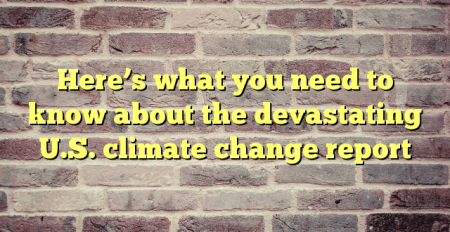November 24, 2018 – I don’t know why departments in the government of the United States continue to issue reports to the public that should influence policy when no one in the executive branch is reading them or listening.
The latest National Climate Assessment, the fourth of its kind required every four years by an act of Congress dating back to 1990, paints a disturbing picture of current and future climate change. And this time it comes with specified costs – hundreds of billions of dollars annually to deal with observed and future damage to the planet, and the American and world economy.
Divided into 16 topic chapters it is likely the document is too much for the current occupier of the White House to read. After all, when he visited California to assess the damage from wildfires, it never occurred to him that these tragic events could be linked to damage present climate change is having on that state. Instead, when asked by reporters if his views on climate change have altered after viewing the extensive destruction, he responded with a firm “no.”
A summary of the assessment follows:
Community Impacts
Impacts are already happening highlighted by frequent and intense extreme weather and climate-related events. The damage to infrastructure occurring today will only get worse as climate change effects become more persistent. For vulnerable communities, it means the likelihood of having to make very tough decisions. Where sea level rise and storm surge cause repeated flooding, communities may have to pick up and move to higher ground. That’s easier for those who are affluent. But for the marginalized and the poor, the lower capacity to cope with extreme weather and other climate change events will be much harder.
Economic Impacts
Rising temperatures, sea level rise, changes in extreme weather events attributed to climate change are increasingly disruptive and damaging to critical infrastructure and property. The impact is being felt beyond the physical affecting industrial, and agricultural production. Equally affected will be supply chains, fisheries, trade, and tourism. And as atmospheric temperatures continue to rise, the efficiency of power generation will decline further impacting all of the above as well as housing. Projected losses estimated reach hundreds of billions of dollars by century-end, “more than the current gross domestic product of many U.S. states.”
Interconnected Impacts
What are interconnected systems? Climate change impacts on the physical environment will have equal effects on social systems. That which affects infrastructure has related consequences impacting clean water availability, food production and distribution, energy and transportation, public health, international trade, and national security. Interconnections go beyond national borders and individual sectors of the economy.
Actions to Reduce Risks
Climate risk decision-making is still missing in action in the House of Representatives, Senate, and Executive Branch of the U.S. government. That was not always the case. The attempt to relax the rules on coal-fired power plants, on oil exploration and development, and on emission and mileage standards for transportation represent setbacks to the country’s efforts to become less carbon dependent. To some degree sub-jurisdictions in the country, including state and municipal governments, as well as businesses are countering the lack of risk assessment. But regional efforts at climate mitigation and adaptation are not at a scale to avoid the ultimate substantial damage that will happen to the economy, environment, and human health as the century unfolds.
Water Impacts
“Rising air and water temperatures and changes in precipitation are intensifying droughts, increasing heavy downpours, reducing snowpack, and causing declines in surface water quality” states the report’s section addressing water supplies and availability for domestic, agricultural, and industrial consumption. Changes to snowmelt, rainfall patterns, and aquifers are creating mismatches between water availability and need. What areas are most affected? The southwest and southern Great Plains, the U.S. Caribbean territories, Hawaii, and U.S. Pacific island possessions. Drought, floods, and saltwater contamination are immediate threats. Availability of water to cool power plants is also a growing risk. Without a concerted strategy to reduce the present and future risk to water, population disruption is bound to happen. So far mitigation and adaptation has been limited.
Health Impacts
Climate change is impacting air quality posing increasing health risks. Increasing wildfires, ground-level ozone, and rising temperatures will mean a rise in environmental change-related mortality. Heat-related deaths are on the rise. Allergic illnesses and asthma as well. And climate change is altering disease vectors as insect pests that carry Lyme disease, malaria, Zika, West Nile, and dengue spread into more of the country. Then there is the impact on mental health from environment-caused loss of income, homes, and communities. Those most impacted will be the marginalized poor. The need to act by introducing adaptation and mitigation programs and policies is needed to prepare individuals, communities, and states for the changes that will increase illness, injuries, and death.
Indigenous Peoples Impacts
Many native people rely more on natural resources to provide for their physical well-being. With natural resources under siege from climate change, it is likely that adverse impacts will fall most heavily, therefore, on these communities. In places like coastal Alaska, indigenous communities are facing having to pick up and move. They are witnessing the impacts on the physical environments which they have used for their livelihoods. From agriculture and agroforestry to fishing, recreation, and tourism, indigenous communities face increasing disruption from extreme weather events and other climate change phenomena. Without adequate financial support, the impact of climate change on indigenous people may lead to them to seek their own adaptation and mitigation strategies. The traditional knowledge of native people may not be enough to overcome the larger environmental insult from climate change.
Ecosystem Impacts
The report states, “increasing wildfire frequency, changes in insect and disease outbreaks, and other stressors are expected to decrease the ability of U.S. forests to support economic activity, recreation, and subsistence activities.” Native species extinctions are already on the rise impacting existing ecosystems. And where native species go, so goes the natural environment. Creating safe havens for threatened species, and controlling invasive species that spread into existing ecosystems because of rising temperatures will require initiatives for which the current governments in the U.S. seem ill-prepared. The few targeted responses underway today are few and far between. Most under threat are coral reefs and Arctic ecosystems.
Agricultural Impacts
Impacts on the health of livestock and crop yields are happening today from drought, rising overnight temperatures, extreme daytime heat, and heavy precipitation events. The threats to agricultural income and rural livelihoods, as well as to sustainable food security and food prices are real. Not all areas will be negatively impacted. The northern parts of the Great Plains will likely see agricultural expansion. But in more traditional agricultural zones, yields of staple crops are expected to decline. It is not just the increase in temperatures that will be the agents of change, declining water quality, and freshwater availability, as well as invasive species, will threaten agricultural production. Changes are possible. Farmers can plant different crops. Agribusiness can develop new crop strains capable of handling the changing environmental conditions. But as climate change impacts increase, at some point, the system will break requiring a massive adaptation effort.
Infrastructure Impacts
What is infrastructure? It includes the energy grid, transportation networks, urban infrastructure including mass transit, roads, sub-surface water and wastewater systems, buildings, and bridges. Add to this pipelines and coastal and river systems and you can see the full extent of what is at risk. Today much of this infrastructure is aging and already under stress. Imagine what extreme weather, coastal flooding, and other climate impacts will do to further put infrastructure to the test. That’s why an adaptation strategy for the country’s infrastructure is needed immediately. Without it, the U.S. will witness accelerated degradation impacting the economy, essential services, health, safety, and national security.
Oceans and Coastal Impacts
Today “rising water temperatures, ocean acidification, retreating Arctic sea ice, sea level rise, high-tide flooding, coastal erosion, higher storm surge, and heavier precipitation events” are already a threat to U.S. ocean waters and coastlines. Marine species are at risk from thermal and chemical changes to coastal ocean waters. And rising seas accompanied by extreme weather events that lead to storm surges are causing increasing financial losses to coastal property and infrastructure. Most vulnerable are the Atlantic and Gulf coastal areas which by mid-century will experience frequent coastal flooding events. The report points out that more than half of coastal property damage could be avoided by the implementation of well-timed adaptation measures. That means significant investment in infrastructure. But without tackling greenhouse gas emissions, any improvements to coastal infrastructure to reduce inundations will only be temporary.
Tourism and Recreation Impacts
Seasonal and outdoor economies are at risk from climate change in the U.S. today. Impacts are spread right across the country, from winter recreation sites to coral reef visits off southern coastlines. Fish, birds, and mammals are expected to change their natural range as the climate gets warmer. That means hunting, and fishing, as well as other wildlife-related activities, will have to adapt. The overall impact is expected to be a drop in tourism revenue as many areas of the country will see natural resources at increasing risk. Concerted efforts at conservation and preservation of natural wildlife refuges may mitigate some of the impacts, but certainly not all.
The Best-Case Scenario
With behavioural changes to how Americans see and respond to climate change, and technological innovations that significantly lower greenhouse gas emissions lessening the financial damage to the country can happen. But the hundreds of billions of dollars annually that climate change will cost may only be reduced by half since the changes are already impacting the country. At best the country has to recover the loss of momentum that occurred with the advent of the Trump administration. More importantly, the U.S. needs to address, in the short-term the increasing risk to the agricultural sector which today is becoming the country’s climate change Achilles Heel.
The authors of the report write “few studies exist that quantify the impact of climate change on U.S. corporations and the effectiveness of adaptation actions to reduce those impacts.” Maybe calculating the dollars and cents lost from not addressing climate change will prove to be a wakeup call to the country to abandon Trump’s anti-climate change policies. Add the mid-term election results and we may begin to see action in the country related on the climate file.
















